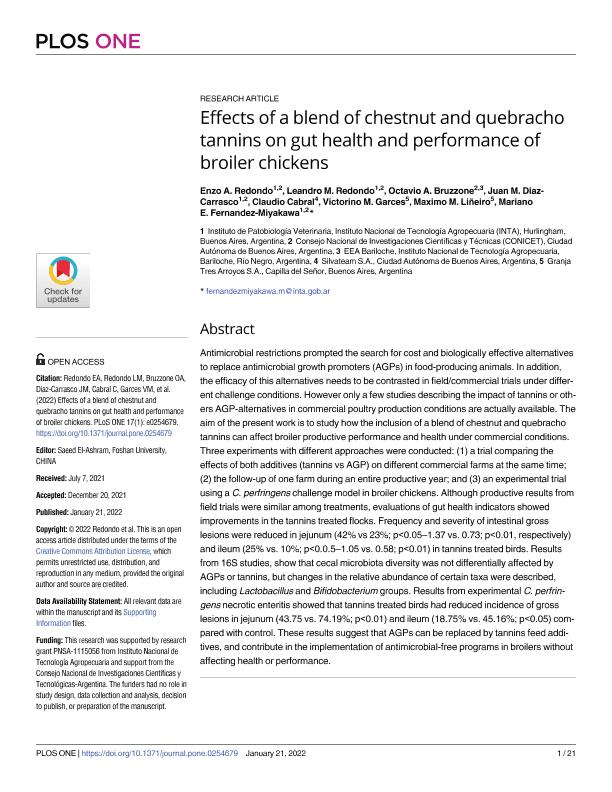Mostrar el registro sencillo del ítem
dc.contributor.author
Redondo, Enzo Alejandro

dc.contributor.author
Redondo, Leandro Martin

dc.contributor.author
Bruzzone, Octavio Augusto

dc.contributor.author
Díaz Carrasco, Juan María

dc.contributor.author
Cabral, Claudio
dc.contributor.author
Garces, Victorino M.
dc.contributor.author
Liñeiro, Maximo M.
dc.contributor.author
Fernandez Miyakawa, Mariano Enrique

dc.date.available
2023-08-17T14:24:51Z
dc.date.issued
2022-01
dc.identifier.citation
Redondo, Enzo Alejandro; Redondo, Leandro Martin; Bruzzone, Octavio Augusto; Díaz Carrasco, Juan María; Cabral, Claudio; et al.; Effects of a blend of chestnut and quebracho tannins on gut health and performance of broiler chickens; Public Library of Science; Plos One; 17; 1; 1-2022; 1-21
dc.identifier.issn
1932-6203
dc.identifier.uri
http://hdl.handle.net/11336/208618
dc.description.abstract
Antimicrobial restrictions prompted the search for cost and biologically effective alternatives to replace antimicrobial growth promoters (AGPs) in food-producing animals. In addition, the efficacy of this alternatives needs to be contrasted in field/commercial trials under different challenge conditions. However only a few studies describing the impact of tannins or others AGP-alternatives in commercial poultry production conditions are actually available. The aim of the present work is to study how the inclusion of a blend of chestnut and quebracho tannins can affect broiler productive performance and health under commercial conditions. Three experiments with different approaches were conducted: (1) a trial comparing the effects of both additives (tannins vs AGP) on different commercial farms at the same time; (2) the follow-up of one farm during an entire productive year; and (3) an experimental trial using a C. perfringens challenge model in broiler chickens. Although productive results from field trials were similar among treatments, evaluations of gut health indicators showed improvements in the tannins treated flocks. Frequency and severity of intestinal gross lesions were reduced in jejunum (42% vs 23%; p<0.05-1.37 vs. 0.73; p<0.01, respectively) and ileum (25% vs. 10%; p<0.0.5-1.05 vs. 0.58; p<0.01) in tannins treated birds. Results from 16S studies, show that cecal microbiota diversity was not differentially affected by AGPs or tannins, but changes in the relative abundance of certain taxa were described, including Lactobacillus and Bifidobacterium groups. Results from experimental C. perfringens necrotic enteritis showed that tannins treated birds had reduced incidence of gross lesions in jejunum (43.75 vs. 74.19%; p<0.01) and ileum (18.75% vs. 45.16%; p<0.05) compared with control. These results suggest that AGPs can be replaced by tannins feed additives, and contribute in the implementation of antimicrobial-free programs in broilers without affecting health or performance.
dc.format
application/pdf
dc.language.iso
eng
dc.publisher
Public Library of Science

dc.rights
info:eu-repo/semantics/openAccess
dc.rights.uri
https://creativecommons.org/licenses/by/2.5/ar/
dc.subject
BROILER
dc.subject
TANNINS
dc.subject
CHESNUT
dc.subject
QUEBRACHO
dc.subject.classification
Producción Animal y Lechería

dc.subject.classification
Producción Animal y Lechería

dc.subject.classification
CIENCIAS AGRÍCOLAS

dc.title
Effects of a blend of chestnut and quebracho tannins on gut health and performance of broiler chickens
dc.type
info:eu-repo/semantics/article
dc.type
info:ar-repo/semantics/artículo
dc.type
info:eu-repo/semantics/publishedVersion
dc.date.updated
2023-07-10T10:36:19Z
dc.journal.volume
17
dc.journal.number
1
dc.journal.pagination
1-21
dc.journal.pais
Estados Unidos

dc.journal.ciudad
San Francisco
dc.description.fil
Fil: Redondo, Enzo Alejandro. Instituto Nacional de Tecnología Agropecuaria. Centro de Investigación En Ciencias Veterinarias y Agronómicas. Instituto de Patobiología Veterinaria.
Consejo Nacional de Investigaciones Científicas y Técnicas. Oficina de Coordinación Administrativa Parque Centenario. Instituto de Patobiología Veterinaria; Argentina
dc.description.fil
Fil: Redondo, Leandro Martin. Instituto Nacional de Tecnología Agropecuaria. Centro de Investigación En Ciencias Veterinarias y Agronómicas. Instituto de Patobiología Veterinaria.
Consejo Nacional de Investigaciones Científicas y Técnicas. Oficina de Coordinación Administrativa Parque Centenario. Instituto de Patobiología Veterinaria; Argentina
dc.description.fil
Fil: Bruzzone, Octavio Augusto. Consejo Nacional de Investigaciones Científicas y Técnicas; Argentina. Instituto Nacional de Tecnología Agropecuaria; Argentina
dc.description.fil
Fil: Díaz Carrasco, Juan María. Instituto Nacional de Tecnología Agropecuaria. Centro de Investigación En Ciencias Veterinarias y Agronómicas. Instituto de Patobiología Veterinaria.
Consejo Nacional de Investigaciones Científicas y Técnicas. Oficina de Coordinación Administrativa Parque Centenario. Instituto de Patobiología Veterinaria; Argentina
dc.description.fil
Fil: Cabral, Claudio. Silvateam S.A; Argentina
dc.description.fil
Fil: Garces, Victorino M.. Granja Tres Arroyos S.A.; Argentina
dc.description.fil
Fil: Liñeiro, Maximo M.. Granja Tres Arroyos S.A.; Argentina
dc.description.fil
Fil: Fernandez Miyakawa, Mariano Enrique. Instituto Nacional de Tecnología Agropecuaria. Centro de Investigación En Ciencias Veterinarias y Agronómicas. Instituto de Patobiología Veterinaria.
Consejo Nacional de Investigaciones Científicas y Técnicas. Oficina de Coordinación Administrativa Parque Centenario. Instituto de Patobiología Veterinaria; Argentina
dc.journal.title
Plos One

dc.relation.alternativeid
info:eu-repo/semantics/altIdentifier/url/https://journals.plos.org/plosone/article?id=10.1371/journal.pone.0254679
dc.relation.alternativeid
info:eu-repo/semantics/altIdentifier/doi/https://doi.org/10.1371/journal.pone.0254679
Archivos asociados
